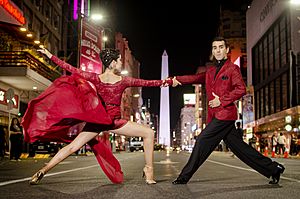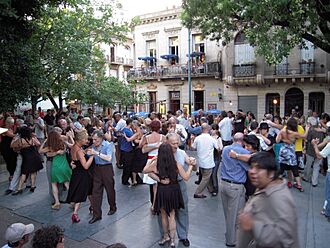Argentine tango facts for kids
Argentine tango is a type of musical genre and a social dance. It started in the late 1800s in the areas around Buenos Aires, Argentina. Tango music usually has a 2
4 or 4
4 rhythm. It often has two or three parts that repeat. The songs often talk about nostalgia, sadness, or lost love. A typical tango orchestra uses many instruments. The bandoneon gives it a special sound. Tango has become very popular around the world. It keeps adding new things but still uses its old traditions. Famous tango artists include singer Carlos Gardel and composers like Francisco Canaro and Ástor Piazzolla.
Contents
History of Tango: How it Started
The exact beginnings of tango are a bit of a mystery. Not many records were kept from that time. But recently, people who love tango have done a lot of research. This has helped us understand its past better. Most people think the dance began in the late 1800s. It grew in the working-class areas of Buenos Aires, Argentina. Argentine dancers, musicians, and immigrants practiced it.
Unlike some other countries, Argentina's rich people often kept different races separate. They used ideas from Europe about non-white people. These people were often forced to live in certain neighborhoods. Tango was danced in streets and courtyards, especially in dark corners. Afro-Argentines (people of African descent in Argentina) were very important. They helped shape tango's music and dance steps early on. The word "tango" itself came from Afro-Argentine dance styles. Black people continued to be linked to tango well into the 1900s. Tango grew as a way for the black community to express their struggles. Many immigrants who lived in poor areas also loved it. They hoped tango could help them improve their lives.
At first, rich Argentines saw tango as dangerous. They thought it was a gathering for lower-class people. But then, famous tango stars like Alberto Castillo became popular. This helped change how people saw tango. Between the 1930s and 1950s, tango became widely accepted in Argentina. Tango songs often challenged how foreigners saw Argentina. They said the real Argentina had both black and white people who created tango. It was not just the rich people who danced other styles. Tango lyrics also often talked about being humble. Mass culture used tango to encourage humility as a national trait.
The government of Buenos Aires and the national government started to support tango. They passed a law to create the Academia Nacional del Tango. This law, called "Ley Nacional del Tango," recognized tango as an important Argentine culture. It was passed in 1996.
At first, the middle and upper classes did not like Argentine tango. They preferred ballroom dances like the Viennese waltz. But between 1910 and 1920, Argentine tango became popular in big European cities. These included Paris, Berlin, Rome, and Vienna. People in Europe had mixed feelings about this new dance. In Rome, King Vittorio Emanuele III banned tango from royal balls. Kaiser Wilhelm II and other kings also stopped their officers from dancing it. In Vienna, tango was left out of a big city ball in the 1920s. But in 2017, Argentine tango finally became part of the traditional Viennese balls. The Technical University Ball now includes a tango dance party.
So, early tango was created by the black community. It was supported by immigrants who wanted to improve their lives. At first, rich people did not accept tango. They even tried to stop it. But tango later gained recognition from the government and rich people. This happened between the 1930s and 1950s. It became a unique part of Argentina's national identity. However, this acceptance by elites might have hidden the fact that black people invented tango in Argentina. It is important to remember tango's true origins and its special history. It has greatly influenced Argentina's national identity.
Tango Music: Rhythms and Styles
Argentine tango music has many different styles. Many orchestras have created a lot of tango music over the last 100 years. There is a huge amount of music, and also many different styles. This variety makes it easy for Argentine tango dancers to dance all night to only tango music.
Four main styles of Argentine tango music are from Di Sarli, d'Arienzo, Troilo, and Pugliese. All four came from Italian immigrant families. They led dance orchestras that played music for dancing. This music often has a clear, repeating beat. It is based on a strong "dos por cuatro" rhythm (two strong beats out of four).
Ástor Piazzolla changed classical music rules with his tango. He moved tango from the dance floor to the concert stage. His music tells stories about modern life. Dancing to his music is more like modern dance.
Historically, Argentine tango dancing was done to traditional tango music. Famous orchestra leaders included Osvaldo Pugliese and Juan d'Arienzo. But in the 1990s, younger tango dancers started dancing to other types of music. This included "world music," "electro-tango," "experimental rock," and "blues." A style called "tango nuevo" is often danced to this alternative music. But it can also be danced to traditional tango.
Here is a list of some tango bandleaders from the "Golden Age" of tango:
- Adolfo Carabelli
- Alberto Di Paulo
- Alfredo De Angelis
- Alfredo Gobbi
- Angel D'Agostino
- Aníbal Troilo
- Armando Cupo
- Carlos di Sarli
- Ciriaco Ortiz
- Juan Maglio Pacho
- Domingo Federico
- Donato Racciatti
- Edgardo Donato
- Enrique Mario Francini
- Enrique Rodriguez
- Florindo Sassone
- Francisco Canaro
- Francisco Lomuto
- Francisco Rotundo
- Héctor Varela
- Horacio Salgán
- José Basso
- Jose Garcia Y Sus Zorros Grices
- Juan Cambareri
- Juan d'Arienzo
- Juan de Dios Filiberto
- Juan Polito
- Julio de Caro
- Lucio Demare
- Manuel Buzón
- Miguel Caló
- Miguel Villasboas
- Osmar Maderna
- Osvaldo Fresedo
- Osvaldo Pugliese
- Pedro Laurenz
- Pedro Maffia
- Ricardo Malerba
- Ricardo Tanturi
- Roberto Firpo
- Rodolfo Biagi
Tango's Comeback Outside Argentina
France: Tango Takes the Stage
In 1983, a dance show called Tango Argentino opened in Paris, France. It was created by Claudio Segovia and Hector Orezzolli. Many famous dancers starred in it, including Juan Carlos Copes and Maria Nieves.
United Kingdom: A New Dance Craze
Argentine tango dancing started in the UK in the early 1990s. This was because of the very popular shows "Forever Tango" and "Tango Argentino". These shows toured all over the world. Andrew Potter, a tango dancer from London, helped start the first tango dance party (called a milonga) in London. It was called "Tango The Argentine Way" and was packed every Friday night. After that, tango dances and classes quickly grew popular across London and the rest of the UK.
United States: From Broadway to Festivals
In 1985, the French show Tango Argentino moved to Broadway in New York City. The dancers from the show also taught classes. Famous actor Robert Duvall was one of their students. Other teachers, like Danel and Maria Bastone, also taught tango in New York.
In 1987, Al and Barbara Garvey from California traveled to Buenos Aires. They wanted to learn the traditional social dance style of tango. When they returned home, they started organizing milongas (tango dance parties) in the San Francisco Bay Area. They also helped create the Bay Area Argentine Tango Association (BAATA).
In 1989, the Dinzelbachers were invited to Cincinnati to teach tango at a dance festival. The next year, the festival moved to Stanford University. These "Stanford Tango Weeks" became very popular annual events. Many famous teachers from Buenos Aires came to teach there. These weeks are seen as a key reason why Argentine tango grew so much in the United States.
In 1990, Luis Bravo's show Forever Tango played in many cities. This made more people want to learn tango. Carlos Gavito, a dancer in Forever Tango, became famous for his unique tango embrace.
In 1998, Nora Dinzelbacher started a new festival called "Nora's Tango Week" in Emeryville, California. This festival continued the spirit of the Stanford Tango Weeks.
By 1994, the number of tango dancers in the San Francisco Bay Area grew very fast. The number of milongas in the area went from three a month to 30. Forever Tango returned to the US in late 1994. It played for a long time in San Francisco and then became the longest-running tango show on Broadway.
Many tango festivals now take place in the United States. Some of these are Seattle Tango Magic, Denver Memorial Day, Portland Valentango, and the Boston Tango Festival.
See also
- Figures of Argentine tango
- Chamarrita
- Finnish tango
- Carlos Gardel
- History of the tango
- Lunfardo
- Maxixe (dance) (or Brazilian tango)
- Milonga (dance event)
- Tango music
- Ballroom tango
- Tango
- Queer Tango
- Uruguayan tango
- World tango dance tournament



